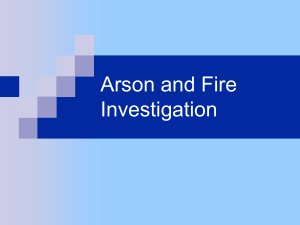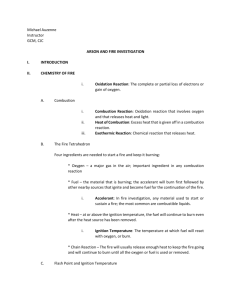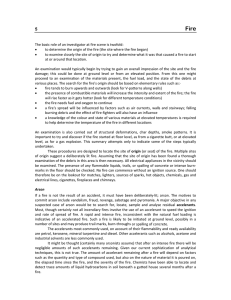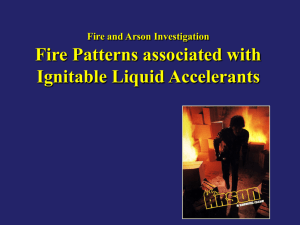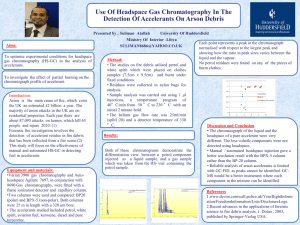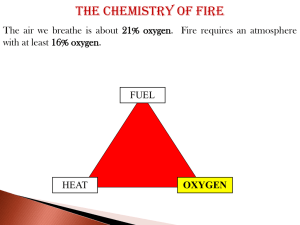FS Fire and Arson - Student
advertisement
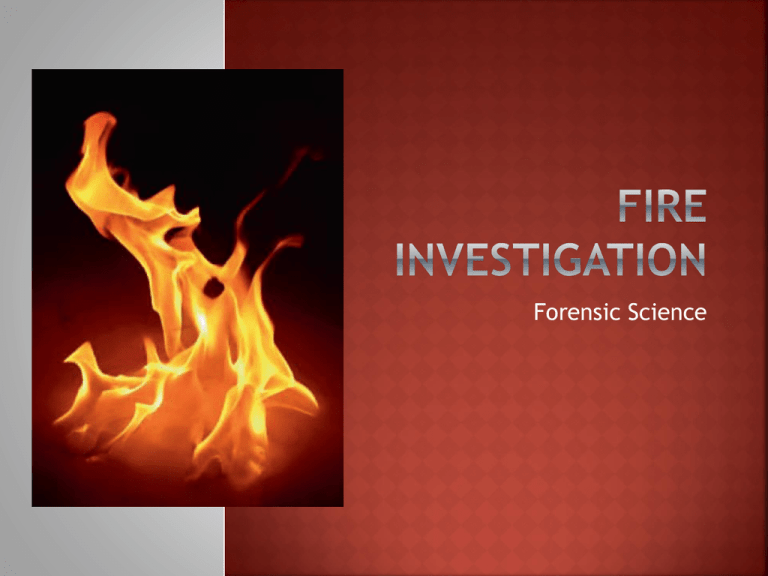
Forensic Science Read about the fire at the Happy Land Social Club What were the materials that created the fire? Why was this fire so deadly? US Fire Data - 2011 NFPA US Fire Data – 2011 Why are graphs used with data? Why was the type of graph chosen? Circle; Line; Bar Examples: What does each graph tell us? Forensic Often uses graphs to help people understand the data and conclusions Develop conclusions based on the data Deaths, Injuries, Property Damage Accidental vs. Intentional Graph Science the data to support your conclusions Support your choice for the type of graph What is needed for a fire? Combustible material (fuel) Oxygen Accelerant = material to start or maintain a fire Activation energy = heat required to start a chemical reaction Fuel + O₂ + activation energy ⇛ What is produced by a fire? Why can it be so destructive? Heat Carbon dioxide Water vapor Incomplete combustion products Fuel + O₂ ⇛ Heat + CO₂ + H₂O + incomplete combustion products Exothermic reactions Reactions that result in the release of heat energy Endothermic reactions Reactions that absorb heat or require heat to be added How do you interpret the diagram? A fuel must be present Oxygen must be available in sufficient quantity Heat must be applied to initiate combustion, and sufficient heat must be generated to sustain the reaction. Chain reaction: Conditions must be capable of sustaining a flaming fire. Fuel, oxygen and heat Wood and charcoal are non-flammable What burns? Wood fire Why do fires burn differently? Charcoal fire Fuel + O₂ ⇛ Heat + CO₂ + H₂O To react with oxygen, most accelerants must be in the gaseous state. Terms Accelerant = material to start or maintain a fire Flash Point = lowest temperature where there is enough heat to change from liquid to gas Ignition Temperature = temperature that allows a fuel to burn and continue burning Heat of combustion – heat generated in a combustion reaction Comparing fuels (accelerants) Which will be the easiest to ignite? 5 Heat transferred from one molecule to another (direct contact) Conductors transfer heat well. Example: Metal Insulators do not transfer heat well. Example: Fiberglass 19 5 Movement of heat through a fluid medium such as air or a liquid Creates convection currents 20 5 Hot gases rise, then travel horizontally. Gases then bank down a wall or move outside the room. Horizontally Vertically 21 5 Transfer of heat in the form of an invisible wave Heat radiated to a nearby structure can ignite it. Radiated heat passing through a window can ignite an object. 22 Combustible Vaporization Non-flammable Solid/liquid/gas Accelerant Pyrolysis Exothermic Arson Heat Hydrocarbon Flash Conduction point Ignition Temperature Heat of combustion Radiation Convection Fire category Point of origin Pattern of fire spread These crimes are carried out at the convenience of the perpetrator and are often "well-planned" to hide crucial evidences (ii) Inability to collect crucial/useful evidence due to the accompanied destruction of the crime scene (iii) volatile evidences are hard to collect and preserve. (i) Starts as soon as the fire has been extinguished. Most arsons are started with petroleum-based accelerants. Does not require a search warrant. Focus on finding the fire’s origin 26 Three basic factors required for combustion: Fuel Oxygen Heat Chemical chain reactions keep the fire burning. Work from the least damaged areas to the most heavily damaged areas. Document with notes, photographs, and videos. Collect evidence (accelerant samples, fire items, and other crime scene evidence.) Interview witnesses Determine the point of origin. Determine the heat source(s). Hypothesize the reasons for the fire. Havana – Laurel Street Practice Burn Photographs What clues might a fire investigator gain from this photograph? Photos provided by Brock Brooks & the Havana Fire Havana – Laurel Street Practice Burn Photographs Photos provided by Brock Brooks & the Havana Fire Practice Burn Photographs A fire started in the kitchen area does not take long before it is a ball of flame reaching quickly to the ceiling. Fires can easily double in size every 60 seconds, meaning there is little time to extinguish a fire before escape should be your Fire fighters look on as the primary goal if trapped. fire spreads across a room. Source: http://www.ci.east-grand-forks.mn.us/fire/gallery/burn/burn.htm The house is nearly completely consumed. Accidental Nature Heating System Electrical appliances Lightning Children playing with matches Smoking Non-Accident Odors – Gas, kerosene, or other accelerants Image: Havana Rural Fire Department Furnishing – Removal of personal objects and valuables Clothing – Check debris for buttons, zippers, etc Locked windows, blocked doors Two or more points of origin Look for inverted v-patterns (can be a sign that an accelerant was used) Floors charred –Can indicate use of an accelerant Trailers (streamers) that lead the fire from one place to another Point of Origin –Location where the fire started. Char Patterns – Point of Origin – Burn patterns and other damage can help determine the point of origin, or the location where the fire started. Char Patterns – Created by very hot fires that burn very quickly and move fast along its path, so that there can be sharp lines between what is burned and what isn't. A char pattern on a door would help an investigator determine which side of the door the fire was on. A char pattern on the floor would help investigators determine the use of an accelerant and its path. V-Patterns - Fire burns up, in a V-shaped pattern, so a fire that starts at an outlet against a wall leaves a char pattern that points to the origin. A very narrow V-shape might indicate a fire that was hotter than normal, such as one helped along by an accelerant. A wide V-shape might indicate a fire that was slow burning. A U-shape could indicate that there was a "pool of origin" rather than a point of origin, such as might be caused by, say, a puddle of gasoline. Heat Shadows - Occur when heavy furniture shields part of a wall; can help determine the origin point. Glass - Glass fragments, windows, and light bulbs can provide clues to a fire. Light bulbs tend to melt toward the heat source, so the "direction of melt" can indicate the direction of the fire. The shattered or cracked glass of the windows can provide indications as to how a fire burned. A dark soot layer on the glass could indicate a slow, smoldering fire. Clear glass with an abnormal pattern of cracking could imply a very hot fire, possibly due to an accelerant. Chimney Effect - Since fire burns upwards, there can be a "chimney effect" where the fire ignites at a point, the superheated gases rise upward and form a fireball, which continues straight up to burn a hole in the ceiling. If the roof is not entirely burnt, and the fire investigator finds such a hole, the origin of the fire could be directly underneath. Color of smoke – Determine what type material was burning Color of flames – Indicates at what temperature the fire was burning. In this lesson, students will examine evidence used in a 1994 case to convict Cameron Todd Willingham, who was executed for the arson & murder of his three young daughters. Students will also review a later study that reexamined the evidence and determined that arson was not involved. Finally, students will judge for themselves whether or not the state proved its case against Willingham. Review terms Watch video segments Complete questions Prepare for discussion In teams: develop an argument which is pro or con the state’s case Frontline video (Chapter 2) Complete worksheet & prepare for the discussion. Frontline – (Chapter 5) In groups of 3: Compare and contrast the evidence Argument: Did the state prove its case? Pro: list supporting factors Against: list negative factors Team states their position & alternative position (s) Explains why position was chosen Write on White Boards Gallery Walk
